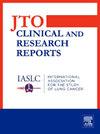表皮生长因子受体突变 NSCLC 患者治疗和转移性疾病模式的变化:学术胸科医学研究者联盟登记分析》(Academic Thoracic Medical Investigator's Consortium Registry Analysis)。
IF 3
Q2 ONCOLOGY
引用次数: 0
摘要
奥西替尼现在是egfr突变(EGFRm)晚期NSCLC的标准一线(1L)治疗药物。我们的目的是表征EGFRm非小细胞肺癌的治疗模式和脑和肝转移的纵向风险。方法:纳入了在学术胸医学研究者联盟范围内接受1L全身治疗的转移性EGFRm NSCLC患者;描述了包括治疗模式在内的人口统计学和临床数据。使用Kaplan-Meier法、Cox回归和累积发生率函数对2015年及以后开始1L治疗的患者的总生存期、到下一次治疗的时间以及脑和肝转移的发生率进行分析。结果:整个队列包括1132例患者,参与者的平均年龄为63.4岁;在参与者中,53%是白人,68%是女性,67%是不吸烟者。在参与者中,830名患者在2015年或之后接受了1L全身治疗。2018年之前首选的egfr -酪氨酸激酶抑制剂是厄洛替尼(65%),2018年之后是奥希替尼(81%)。1L治疗开始后到下一次治疗的中位时间为13.9个月,接受1L奥西替尼治疗的患者最长(28个月)。在2015年后队列中,脑转移(BM)的基线患病率为54%,而在基线无脑转移的患者中,12、24和48个月发生脑转移的概率分别为8%、22%和44%。基线无脑转移的患者在治疗期间发生脑转移与死亡风险增加3.2倍相关。结论:即使在普遍使用奥西替尼的当代,基底细胞瘤发展的基线和纵向风险也很高。发展为脑转移的持续风险,以及相关的生存损害,要求对EGFRm非小细胞肺癌患者进行常规脑磁共振成像监测,目前未包括在指南中。本文章由计算机程序翻译,如有差异,请以英文原文为准。
Changing Treatment and Metastatic Disease Patterns in Patients with EGFR Mutated NSCLC: An Academic Thoracic Medical Investigator’s Consortium Registry Analysis
Introduction
Osimertinib is now a standard first-line (1L) therapy for EGFR-mutated (EGFRm) advanced NSCLC. We aimed to characterize patterns of therapy and longitudinal risk of brain and liver metastasis in a cohort of EGFRm NSCLC.
Methods
Patients with metastatic EGFRm NSCLC who received 1L systemic therapy at sites within the Academic Thoracic Medical Investigator’s Consortium were included; demographic and clinical data including treatment patterns were described. Analyses of overall survival, time to next treatment, and incident brain and liver metastasis were performed using the Kaplan-Meier method, Cox regression, and cumulative incidence functions on patients who started 1L therapy in 2015 or later.
Results
The full cohort included 1132 patients and the mean age of the participants was 63.4 years; among the participants, 53% were White individuals, 68% were female individuals, and 67% were nonsmokers. Among the participants, 830 patients received 1L systemic therapy in 2015 or later. The predominant first EGFR–tyrosine kinase inhibitor was erlotinib (65%) before 2018 and osimertinib (81%) after 2018. The median time to the next treatment after the start of 1L therapy was 13.9 months overall and the longest in patients receiving 1L osimertinib (28 months). In the post-2015 cohort, the baseline prevalence of brain metastasis (BM) was 54% and among patients without baseline brain metastasis, the probability of incident BM at 12, 24, and 48 months was 8%, 22%, and 44%, respectively. Development of an on-treatment brain metastasis among patients without baseline brain metastasis was associated with a 3.2 times higher risk of death.
Conclusion
Even in a contemporary era with prevalent osimertinib use, the baseline and longitudinal risk of BM development was high. The ongoing risk of developing BM, together with the associated survival detriment, argues for routine surveillance of the brain through magnetic resonance imaging for patients with EGFRm NSCLC, which is not currently included in the guidelines.
求助全文
通过发布文献求助,成功后即可免费获取论文全文。
去求助
来源期刊

JTO Clinical and Research Reports
Medicine-Oncology
CiteScore
4.20
自引率
0.00%
发文量
145
审稿时长
19 weeks
 求助内容:
求助内容: 应助结果提醒方式:
应助结果提醒方式:


